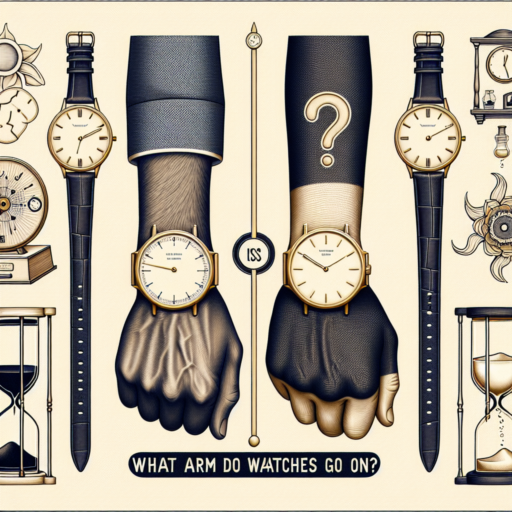Does it matter what arm you wear your watch on?
Many watch enthusiasts and newcomers alike often ponder the question: Does it matter what arm you wear your watch on? Traditionally, watches have been worn on the left wrist, largely due to the dominance of right-handed individuals in the population. This conventional wisdom suggests that wearing your watch on the non-dominant hand makes it less susceptible to damage while also ensuring ease of manipulation of the watch’s controls with the dominant hand.
However, in the modern age where personal preference and functionality intersect more than ever, the rules are not as rigid. For left-handed individuals, wearing a watch on the right wrist might be more comfortable and practical. This switch allows for a natural movement without interfering with the writs’ motion. The idea is to wear your watch where it feels most comfortable and where it’s less likely to get in the way of daily activities.
Style considerations also come into play when deciding on which wrist to wear your watch. Some fashion-forward individuals choose to wear their watches on a specific arm as a statement piece, regardless of practicality or traditional norms. The choice between wearing a watch on the left or right wrist can also be influenced by the type of watch, its weight, and the wearer’s activity level. Ultimately, the decision is highly personal and varies from one individual to another.
Is it okay to wear a watch on your right hand?
The question of whether it’s acceptable to wear a watch on your right hand might seem straightforward, but it actually touches on a variety of preferences, traditions, and practicalities. Historically, watches have been predominantly worn on the left wrist. This convention stems from the fact that most people are right-handed and wearing a watch on the non-dominant hand makes it less susceptible to damage and easier to operate. However, the norms around watch-wearing are evolving, reflecting a broader range of personal styles and functional considerations.
In the context of personal style, choosing which wrist to adorn with a watch is increasingly seen as a reflection of individuality rather than strict adherence to tradition. People might choose to wear their watch on the right wrist for a variety of reasons, including comfort, ease of access, or simply personal preference. Especially for those who are left-handed, wearing a watch on the right wrist can offer practical advantages, making it easier to check the time without interrupting the flow of work or activity.
From a practical standpoint, there’s no correct or incorrect wrist to wear a watch. Modern watch design accommodates wearers of both preferences, with features like reversible faces or ambidextrous control buttons becoming more common. Whether for fashion, comfort, or functionality, the choice of which wrist to wear a watch on is ultimately a personal one. As societal norms around accessories and fashion continue to evolve, so too does the acceptance of wearing watches on either wrist.
Why are watches worn on the left wrist?
One of the most common reasons watches are traditionally worn on the left wrist is due to the majority of the population being right-handed. This practice ensures that the watch does not interfere with the dominant hand’s activities, making daily tasks easier and preventing potential damage to the watch. It also allows for smoother and more efficient time checking since the wearer can continue working with their dominant hand while glancing at their watch.
Another factor contributing to the preference for wearing watches on the left wrist is the design of the watch itself. Most watches are designed with the crown on the right side of the watch face, making it more convenient for right-handed users to adjust the time and settings with their dominant hand. For left-handed wearers, this placement might be less convenient, yet the tradition persists due to long-standing habits and the watches’ design standard.
Comfort also plays a significant role in the choice of wrist. The left wrist, being generally less used for strenuous activities, offers a safer and more comfortable position for the watch, reducing the likelihood of sweating and irritation. Moreover, wearing the watch on the non-dominant hand minimizes the risk of impacting the watch’s mechanism through less exposure to shocks and bumps that the dominant hand might encounter.
No se han encontrado productos.
Why do Muslims wear watches in the right hand?
The practice of wearing watches on the right hand among Muslims is primarily associated with practicality and religious considerations. This tradition is not universally adhered to by all Muslims but is commonplace in many Islamic cultures. The reasoning behind this custom is rooted in both the practical aspects of daily life and the symbolic significance found within Islamic tradition.
Cultural and Practical Considerations
One of the main reasons for Muslims wearing watches on the right hand relates to the norm of using the left hand for personal hygiene and the right hand for cleaner tasks, such as eating and greeting others. By wearing a watch on the right wrist, it not only symbolizes cleanliness and purity but also avoids associating the item with actions considered less clean. This distinction is deeply embedded in many Islamic societies, emphasizing the importance of cleanliness and etiquette.
Religious Symbolism
In addition to practical reasons, there is also a symbolic aspect to wearing the watch on the right hand. In Islamic culture, the right side is often associated with good fortune and righteousness. This belief extends to various practices, including the preference for entering mosques with the right foot first and eating with the right hand. Therefore, wearing a watch on the right wrist can be seen as a reflection of striving for righteousness and aligning with positive symbolism.
While wearing watches on the right hand is a practice observed by some Muslims, it is important to remember that these customs vary widely among individuals and communities. The choice often reflects a blend of personal comfort, cultural traditions, and religious beliefs, illustrating the diversity within the Islamic world.




